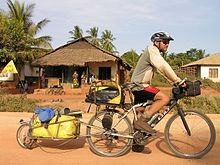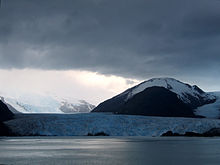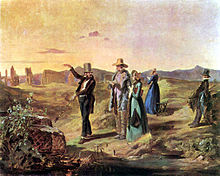
Tourism
Background Information
SOS Children produced this website for schools as well as this video website about Africa. Click here to find out about child sponsorship.
Tourism is travel for recreational, leisure, or business purposes. The World Tourism Organization defines tourists as people "traveling to and staying in places outside their usual environment for not more than one consecutive year for leisure, business and other purposes".
Tourism has become a popular global leisure activity. In 2011, there were over 983 million international tourist arrivals worldwide, representing a growth of 4.6% when compared to 940 million in 2010. International tourism receipts (the travel item of the balance of payments) grew to US$1.03 trillion (€740 billion) in 2011, corresponding to an increase in real terms of 3.8% from 2010. In 2011, international travel demand continued to recover from the losses resulting from the late-2000s recession, where tourism suffered a strong slowdown from the second half of 2008 through the end of 2009. After a 5% increase in the first half of 2008, growth in international tourist arrivals moved into negative territory in the second half of 2008, and ended up only 2% for the year, compared to a 7% increase in 2007. The negative trend intensified during 2009, exacerbated in some countries due to the outbreak of the H1N1 influenza virus, resulting in a worldwide decline of 4.2% in 2009 to 880 million international tourists arrivals, and a 5.7% decline in international tourism receipts.
Tourism is important, and in some cases, vital for many countries. It was recognized in the Manila Declaration on World Tourism of 1980 as "an activity essential to the life of nations because of its direct effects on the social, cultural, educational, and economic sectors of national societies and on their international relations." Tourism brings in large amounts of income in payment for goods and services available, accounting for 30% of the world's exports of services, and 6% of overall exports of goods and services. It also creates opportunities for employment in the service sector of the economy, associated with tourism. These service industries include transportation services, such as airlines, cruise ships, and taxicabs; hospitality services, such as accommodations, including hotels and resorts; and entertainment venues, such as amusement parks, casinos, shopping malls, music venues, and theatres.
Etymology
Theobald (1994) suggested that "etymologically, the word tour is derived from the Latin, 'tornare' and the Greek, 'tornos', meaning 'a lathe or circle; the movement around a central point or axis'. This meaning changed in modern English to represent 'one's turn'. The suffix –ism is defined as 'an action or process; typical behaviour or quality', while the suffix, –ist denotes 'one that performs a given action'. When the word tour and the suffixes –ism and –ist are combined, they suggest the action of movement around a circle. One can argue that a circle represents a starting point, which ultimately returns back to its beginning. Therefore, like a circle, a tour represents a journey in that it is a round-trip, i.e., the act of leaving and then returning to the original starting point, and therefore, one who takes such a journey can be called a tourist."
In 1941, Hunziker and Krapf defined tourism as people who travel "the sum of the phenomena and relationships arising from the travel and stay of non-residents, insofar as they do not lead to permanent residence and are not connected with any earning activity." In 1976, the Tourism Society of England's definition was: "Tourism is the temporary, short-term movement of people to destination outside the places where they normally live and work and their activities during the stay at each destination. It includes movements for all purposes." In 1981, the International Association of Scientific Experts in Tourism defined tourism in terms of particular activities selected by choice and undertaken outside the home.
In 1994, the United Nations classified three forms of tourism in its Recommendations on Tourism Statistics:
- Domestic tourism, involving residents of the given country traveling only within this country.
- Inbound tourism, involving non-residents traveling in the given country.
- Outbound tourism, involving residents traveling in another country.
World tourism statistics and rankings
Total volume of cross-border tourist travel
In 2011, there were 983 million international tourist arrivals, with a growth of 4.6% as compared to 2010. In 2012 this rose to more than 1 billion international arrivals.
Most-visited countries by international tourist arrivals
The World Tourism Organization reports the following ten countries as the most visited in terms of the number of international travellers. In 2011, Turkey overtook the United Kingdom to become the sixth most visited country.
| Rank | Country | UNWTO Region |
International tourist arrivals (2011) |
International tourist arrivals (2010) |
Change 2010 to 2011 |
|---|---|---|---|---|---|
| 1 | Europe | 79.5 million | 77.1 million | +3.0% | |
| 2 | North America | 62.3 million | 59.8 million | +4.2% | |
| 3 | Asia | 57.6 million | 55.7 million | +3.4% | |
| 4 | Europe | 56.7 million | 52.7 million | +7.6% | |
| 5 | Europe | 46.1 million | 43.6 million | +5.7% | |
| 6 | Europe | 33.3 million | 27.0 million | +8.7% | |
| 7 | Europe | 29.2 million | 28.3 million | +3.2% | |
| 8 | Europe | 28.4 million | 26.9 million | +5.5% | |
| 9 | Asia | 24.7 million | 24.6 million | +0.6% | |
| 10 | North America | 23.4 million | 23.3 million | +0.5% |
International tourism receipts
International tourism receipts grew to US$1.03 trillion (€740 billion) in 2011, corresponding to an increase in real terms of 3.8% from 2010. The World Tourism Organization reports the following countries as the top ten tourism earners for the year 2011, with the United States by far the top earner.
| Rank | Country | UNWTO Region |
International tourism receipts (2011) |
|---|---|---|---|
| 1 | North America | $116.3 billion | |
| 2 | Europe | $59.9 billion | |
| 3 | Europe | $53.8 billion | |
| 4 | Asia | $48.5 billion | |
| 5 | Europe | $43.0 billion | |
| 6 | Europe | $38.8 billion | |
| 7 | Europe | $35.9 billion | |
| 8 | Oceania | $31.4 billion | |
| 9 | Asia | $27.8 billion | |
| 10 | Asia | $27.2 billion |
International tourism expenditure
The World Tourism Organization reports the following countries as the top ten biggest spenders on international tourism for the year 2011.
| Rank | Country | UNWTO Region |
International tourism expenditure (2011) |
|---|---|---|---|
| 1 | Europe | $84.3 billion | |
| 2 | North America | $79.1 billion | |
| 3 | Asia | $72.6 billion | |
| 4 | Europe | $50.6 billion | |
| 5 | Europe | $41.7 billion | |
| 6 | North America | $33.0 billion | |
| 7 | Europe | $32.5 billion | |
| 8 | Europe | $28.7 billion | |
| 9 | Asia | $27.2 billion | |
| 10 | Oceania | $26.9 billion |
History
Wealthy people have always travelled to distant parts of the world, to see great buildings, works of art, learn new languages, experience new cultures, and to taste different cuisines. Long ago, at the time of the Roman Republic, places such as Baiae were popular coastal resorts for the rich. The word tourist was used by 1772 and tourism by 1811.
The origins of modern tourism can be traced back to what was known as the Grand Tour which was a traditional trip of Europe undertaken by mainly upper-class European young men of means, mainly from England. The custom flourished from about 1660 until the advent of large-scale rail transit in the 1840s, and was associated with a standard itinerary. It served as an educational rite of passage. Though primarily associated with the British nobility and wealthy landed gentry, similar trips were made by wealthy young men of Protestant Northern European nations on the Continent, and from the second half of the 18th century some South American, U.S., and other overseas youth joined in. The tradition was extended to include more of the middle class after rail and steamship travel made the journey less of a burden, and Thomas Cook made the "Cook's Tour" a byword.
The New York Times recently described the Grand Tour in this way:
Three hundred years ago, wealthy young Englishmen began taking a post- Oxbridge trek through France and Italy in search of art, culture and the roots of Western civilization. With nearly unlimited funds, aristocratic connections and months (or years) to roam, they commissioned paintings, perfected their language skills and mingled with the upper crust of the Continent.—Gross, Matt., " Lessons From the Frugal Grand Tour." New York Times 5 September 2008.
The primary value of the Grand Tour, it was believed, laid in the exposure both to the cultural legacy of classical antiquity and the Renaissance, and to the aristocratic and fashionably polite society of the European continent.
Emergence of Leisure travel
Leisure travel was associated with the Industrial Revolution in the United Kingdom – the first European country to promote leisure time to the increasing industrial population. Initially, this applied to the owners of the machinery of production, the economic oligarchy, the factory owners and the traders. These comprised the new middle class. Cox & Kings was the first official travel company to be formed in 1758.
The British origin of this new industry is reflected in many place names. In Nice, France, one of the first and best-established holiday resorts on the French Riviera, the long esplanade along the seafront is known to this day as the Promenade des Anglais; in many other historic resorts in continental Europe, old, well-established palace hotels have names like the Hotel Bristol, Hotel Carlton, or Hotel Majestic – reflecting the dominance of English customers.
A pioneer of the travel agency, Thomas Cook's idea to offer excursions came to him while waiting for the stagecoach on the London Road at Kibworth. With the opening of the extended Midland Counties Railway, he arranged to take a group of 540 temperance campaigners from Leicester Campbell Street station to a rally in Loughborough, eleven miles away. On 5 July 1841, Thomas Cook arranged for the rail company to charge one shilling per person that included rail tickets and food for this train journey. Cook was paid a share of the fares actually charged to the passengers, as the railway tickets, being legal contracts between company and passenger, could not have been issued at his own price. This was the first privately chartered excursion train to be advertised to the general public; Cook himself acknowledging that there had been previous, unadvertised, private excursion trains. During the following three summers he planned and conducted outings for temperance societies and Sunday-school children. In 1844 the Midland Counties Railway Company agreed to make a permanent arrangement with him provided he found the passengers. This success led him to start his own business running rail excursions for pleasure, taking a percentage of the railway tickets.
Four years later, he planned his first excursion abroad, when he took a group from Leicester to Calais to coincide with the Paris Exhibition. The following year he started his 'grand circular tours' of Europe. During the 1860s he took parties to Switzerland, Italy, Egypt and United States. Cook established 'inclusive independent travel', whereby the traveller went independently but his agency charged for travel, food and accommodation for a fixed period over any chosen route. Such was his success that the Scottish railway companies withdrew their support between 1862 and 1863 to try the excursion business for themselves.
Modern Day Tourism
Many leisure-oriented tourists travel to the tropics, both in the summer and winter. Places of such nature often visited are: Bali in Indonesia, Colombia, Brazil, Cuba, Grenada, the Dominican Republic, Malaysia, Mexico the various Polynesian tropical islands, Queensland in Australia, Thailand, Saint-Tropez and Cannes in France, Florida, Hawaii and Puerto Rico, in the United States, Saint Vincent and the Grenadines, Barbados, Trinidad and Tobago, Jamaica, St.Lucia Saint Maarten, St. Martin's Island in Bangladesh, Saint Kitts and Nevis, The Bahamas, Anguilla, Antigua and Barbuda, Aruba, Turks and Caicos Islands, and Bermuda.
In 1936, the League of Nations defined foreign tourist as "someone traveling abroad for at least twenty-four hours". Its successor, the United Nations, amended this definition in 1945, by including a maximum stay of six months.
Winter tourism
Although it is acknowledged that the Swiss were not the inventors of skiing, it is well documented that St. Moritz, Graubünden became the cradle of the developing winter tourism; since that year of 1865 in St. Moritz, when many daring hotel managers choose to risk opening their hotels in winter. It was, however, only in the 1970s when winter tourism took over the lead from summer tourism in many of the Swiss ski resorts. Even in winter, portions of up to one third of all guests (depending on the location) consist of non-skiers.
Major ski resorts are located mostly in the various European countries (e.g. Andorra, Austria, Bulgaria, Bosnia-Herzegovina, Czech Republic, Cyprus, Finland, France, Germany, Iceland, Italy, Norway, Latvia, Lithuania, Poland, Serbia, Sweden, Slovakia, Slovenia, Spain, Switzerland, Turkey), Canada, the United States (e.g. Colorado, California, Utah, Montana, Wyoming, New York, New Jersey, Michigan, Vermont, New Hampshire) New Zealand, Japan, South Korea, Chile, and Argentina.
Mass tourism
Mass tourism could only have developed with the improvements in technology, allowing the transport of large numbers of people in a short space of time to places of leisure interest, so that greater numbers of people could begin to enjoy the benefits of leisure time.
In the United States, the first seaside resorts in the European style were at Atlantic City, New Jersey and Long Island, New York.
In Continental Europe, early resorts included: Ostend, popularised by the people of Brussels; Boulogne-sur-Mer ( Pas-de-Calais) and Deauville ( Calvados) for the Parisians; and Heiligendamm, founded in 1793, as the first seaside resort on the Baltic Sea.
Adjectival tourism
Adjectival tourism refers to the numerous niche or specialty travel forms of tourism that have emerged over the years, each with its own adjective. Many of these have come into common use by the tourism industry and academics. Others are emerging concepts that may or may not gain popular usage. Examples of the more common niche tourism markets include:
|
|
Recent developments
There has been an up-trend in tourism over the last few decades, especially in Europe, where international travel for short breaks is common. Tourists have a wide range of budgets and tastes, and a wide variety of resorts and hotels have developed to cater for them. For example, some people prefer simple beach vacations, while others want more specialised holidays, quieter resorts, family-oriented holidays or niche market-targeted destination hotels.
The developments in technology and transport infrastructure, such as jumbo jets, low-cost airlines and more accessible airports have made many types of tourism more affordable. On 28 April 2009 The Guardian noted that "the WHO estimates that up to 500,000 people are on planes at any time." There have also been changes in lifestyle, for example some retirement-age people sustain year round tourism. This is facilitated by internet sales of tourist services. Some sites have now started to offer dynamic packaging, in which an inclusive price is quoted for a tailor-made package requested by the customer upon impulse.
There have been a few setbacks in tourism, such as the September 11 attacks and terrorist threats to tourist destinations, such as in Bali and several European cities. Also, on 26 December 2004, a tsunami, caused by the 2004 Indian Ocean earthquake, hit the Asian countries on the Indian Ocean, including the Maldives. Thousands of lives were lost including many tourists. This, together with the vast clean-up operations, stopped or severely hampered tourism in the area for a time.
The terms tourism and travel are sometimes used interchangeably. In this context, travel has a similar definition to tourism, but implies a more purposeful journey. The terms tourism and tourist are sometimes used pejoratively, to imply a shallow interest in the cultures or locations visited by tourists.
Sustainable tourism
"Sustainable tourism is envisaged as leading to management of all resources in such a way that economic, social and aesthetic needs can be fulfilled while maintaining cultural integrity, essential ecological processes, biological diversity and life support systems." ( World Tourism Organization)
Sustainable development implies "meeting the needs of the present without compromising the ability of future generations to meet their own needs." ( World Commission on Environment and Development, 1987)
Sustainable tourism can be seen as having regard to ecological and socio-cultural carrying capacities and includes involving the community of the destination in tourism development planning. It also involves integrating tourism to match current economic and growth policies so as to mitigate some of the negative economic and social impacts of 'mass tourism'. Murphy (1985) advocates the use of an 'ecological approach', to consider both 'plants' and 'people' when implementing the sustainable tourism development process. This is in contrast to the ' boosterism' and ' economic' approaches to tourism planning, neither of which consider the detrimental ecological or sociological impacts of tourism development to a destination.
However, Butler questions the exposition of the term 'sustainable' in the context of tourism, citing its ambiguity and stating that "the emerging sustainable development philosophy of the 1990s can be viewed as an extension of the broader realization that a preoccupation with economic growth without regard to its social and environmental consequences is self-defeating in the long term." Thus 'sustainable tourism development' is seldom considered as an autonomous function of economic regeneration as separate from general economic growth.
Ecotourism
Ecotourism, also known as ecological tourism, is responsible travel to fragile, pristine, and usually protected areas that strives to be low impact and (often) small scale. It helps educate the traveler; provides funds for conservation; directly benefits the economic development and political empowerment of local communities; and fosters respect for different cultures and for human rights.
Pro-poor tourism

Pro-poor tourism, which seeks to help the poorest people in developing countries, has been receiving increasing attention by those involved in development; the issue has been addressed through small-scale projects in local communities and through attempts by Ministries of Tourism to attract large numbers of tourists. Research by the Overseas Development Institute suggests that neither is the best way to encourage tourists' money to reach the poorest as only 25% or less (far less in some cases) ever reaches the poor; successful examples of money reaching the poor include mountain-climbing in Tanzania and cultural tourism in Luang Prabang, Laos.
Recession tourism
Recession tourism is a travel trend, which evolved by way of the world economic crisis. Identified by American entrepreneur Matt Landau (2007), recession tourism is defined by low-cost, high-value experiences taking place of once-popular generic retreats. Various recession tourism hotspots have seen business boom during the recession thanks to comparatively low costs of living and a slow world job market suggesting travelers are elongating trips where their money travels further.
Medical tourism
When there is a significant price difference between countries for a given medical procedure, particularly in Southeast Asia, India, Eastern Europe and where there are different regulatory regimes, in relation to particular medical procedures (e.g. dentistry), traveling to take advantage of the price or regulatory differences is often referred to as "medical tourism".
Educational tourism
Educational tourism developed, because of the growing popularity of teaching and learning of knowledge and the enhancing of technical competency outside of the classroom environment. In educational tourism, the main focus of the tour or leisure activity includes visiting another country to learn about the culture, such as in Student Exchange Programs and Study Tours, or to work and apply skills learned inside the classroom in a different environment, such as in the International Practicum Training Program.
Creative tourism
Creative tourism has existed as a form of cultural tourism, since the early beginnings of tourism itself. Its European roots date back to the time of the Grand Tour, which saw the sons of aristocratic families traveling for the purpose of mostly interactive, educational experiences. More recently, creative tourism has been given its own name by Crispin Raymond and Greg Richards, who as members of the Association for Tourism and Leisure Education (ATLAS), have directed a number of projects for the European Commission, including cultural and crafts tourism, known as sustainable tourism. They have defined "creative tourism" as tourism related to the active participation of travellers in the culture of the host community, through interactive workshops and informal learning experiences.
Meanwhile, the concept of creative tourism has been picked up by high-profile organizations such as UNESCO, who through the Creative Cities Network, have endorsed creative tourism as an engaged, authentic experience that promotes an active understanding of the specific cultural features of a place.
More recently, creative tourism has gained popularity as a form of cultural tourism, drawing on active participation by travelers in the culture of the host communities they visit. Several countries offer examples of this type of tourism development, including the United Kingdom, Austria, France, the Bahamas, Jamaica, Spain, Italy and New Zealand.
Dark tourism
One emerging area of special interest has been identified by Lennon and Foley (2000) as "dark" tourism. This type of tourism involves visits to "dark" sites, such as battlegrounds, scenes of horrific crimes or acts of genocide, for example: concentration camps. Dark tourism remains a small niche market, driven by varied motivations, such as mourning, remembrance, education, macabre curiosity or even entertainment. Its early origins are rooted in fairgrounds and medieval fairs.
Doom tourism

Also known as "Tourism of Doom," or "Last Chance Tourism" this emerging trend involves traveling to places that are environmentally or otherwise threatened (the ice caps of Mount Kilimanjaro, the melting glaciers of Patagonia, The coral of the Great Barrier Reef) before it is too late. Identified by travel trade magazine Travel Age West editor-in-chief Kenneth Shapiro in 2007 and later explored in The New York Times, this type of tourism is believed to be on the rise. Some see the trend as related to sustainable tourism or ecotourism due to the fact that a number of these tourist destinations are considered threatened by environmental factors such as global warming, over population or climate change. Others worry that travel to many of these threatened locations increases an individual’s carbon footprint and only hastens problems threatened locations are already facing.
Growth
The World Tourism Organization (UNWTO) forecasts that international tourism will continue growing at the average annual rate of 4%. With the advent of e-commerce, tourism products have become one of the most traded items on the internet. Tourism products and services have been made available through intermediaries, although tourism providers (hotels, airlines, etc.) can sell their services directly. This has put pressure on intermediaries from both on-line and traditional shops.
It has been suggested there is a strong correlation between tourism expenditure per capita and the degree to which countries play in the global context. Not only as a result of the important economic contribution of the tourism industry, but also as an indicator of the degree of confidence with which global citizens leverage the resources of the globe for the benefit of their local economies. This is why any projections of growth in tourism may serve as an indication of the relative influence that each country will exercise in the future.
Space tourism is expected to "take off" in the first quarter of the 21st century, although compared with traditional destinations the number of tourists in orbit will remain low until technologies such as a space elevator make space travel cheap.
Technological improvement is likely to make possible air-ship hotels, based either on solar-powered airplanes or large dirigibles. Underwater hotels, such as Hydropolis, expected to open in Dubai in 2009, will be built. On the ocean, tourists will be welcomed by ever larger cruise ships and perhaps floating cities.
Sports tourism
Since the late 1980s, sports tourism has become increasingly popular. Events such as rugby, Olympics, Commonwealth games, Asian Games and football World Cups have enabled specialist travel companies to gain official ticket allocation and then sell them in packages that include flights, hotels and excursions.
The focus on sport and spreading knowledge on the subject, especially more so recently, lead to the increase in the sport tourism. Most notably, the international event such as the Olympics caused a shift in focus in the audience who now realize the variety of sports that exist in the world. In the United States, one of the most popular sports that usually are focused on was Football. This popularity was increased through major events like the World Cups. In Asian countries, the numerous football events also increased the popularity of football. But, it was the Olympics that brought together the different sports that lead to the increase in sport tourism. The drastic interest increase in sports in general and not just one sport caught the attention of travel companies, who then began to sell flights in packages. Due to the low number of people who actually purchase these packages than predicted, the cost of these packages plummeted initially. As the number start to rise slightly the packages increased to regain the lost profits. With the certain economic state, the number of purchases decreased once again. The fluctuation in the number of packages sold was solely dependent on the economic situation, therefore, most travel companies were forced to set aside the plan to execute the marketing of any new package features.
Latest trends
As a result of the late-2000s recession, international arrivals suffered a strong slowdown beginning in June 2008. Growth from 2007 to 2008 was only 3.7% during the first eight months of 2008. This slowdown on international tourism demand was also reflected in the air transport industry, with a negative growth in September 2008 and a 3.3% growth in passenger traffic through September. The hotel industry also reported a slowdown, with room occupancy declining. In 2009 worldwide tourism arrivals decreased by 3.8%. By the first quarter of 2009, real travel demand in the United States had fallen 6% over six quarters. While this is considerably milder than what occurred after the 9/11 attacks, the decline was at twice the rate as real GDP has fallen.
However, evidence suggests that tourism as a global phenomena shows no signs of substantially abating in the long term. Much literature, especially that following the Mobilities paradigm, suggests that travel is necessary in order to maintain relationships, as social life is increasingly networked and conducted at a distance. For many vacations and travel are increasingly being viewed as a necessity rather than a luxury, and this is reflected in tourist numbers recovering some 6.6% globally over 2009, with growth up to 8% in emerging economies.






